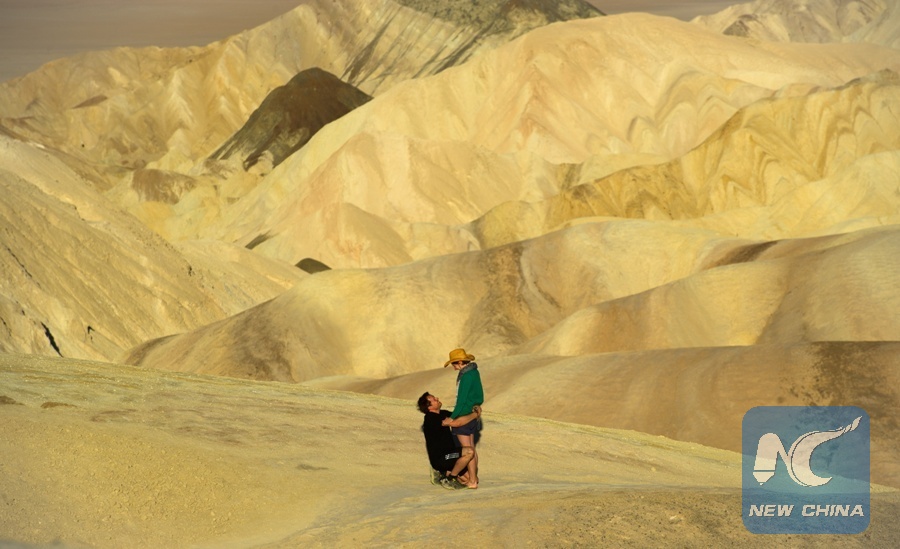U.S. wilderness becomes new magnet for Chinese tourists
A couple are seen at Death Valley National Park in the United States.
About 10 years ago, Jin Chen's parents did not know much about Alaska, where she was studying. Their neighbors often confused the remotest
U.S. state with Las Vegas, a city known in China for its casinos.
Yet now, Alaska, with its vast wilderness, is among the hot U.S. destinations for deep-pocketed Chinese tourists.
"Our business has seen an annual increase of over 50 percent in recent years," Jin Chen, chief executive officer of Alaska Skylar Travel, which caters to Asian markets by coordinating Mandarin-speaking tours in Anchorage, Alaska's largest city, told Xinhua in a recent interview.
Alaska has become a top choice for young Chinese tourists who have visited the United States more than once, Chen said. Alaska's natural beauty, glimpsed in the aurora borealis and glaciers, was becoming more attractive to young Chinese than the crowded mega-city life in New York and Los Angeles.
Deb Hickok, president and chief executive of Explore Fairbanks, a non-profit organization promoting tourism in Alaska's second largest city Fairbanks, also noticed the new trend.
"The aurora is a big driver for Chinese tourism for our area and we see the rapid growth from China," Hickok said.
With help from Chen's company, Anchorage and Fairbanks have undertaken a "China Ready" program, helping the travel industry with materials, training, guides and tools to understand, target and accommodate the market, she said.
Alaska, dubbed the Last Frontier, is just one of the new areas in the U.S. wilderness that young Chinese tourists with more disposable income are seeking out.
GREAT OUTDOORS, GREAT EXPECTATIONS
According to the National Travel and Tourism Office (NTTO) at the U.S. Department of Commerce, in 2016 there were 2.97 million arrivals from China, making China the fifth largest source country in international visits to the United States. Of those arrivals, 1.2 million (about 41 percent) visited national parks and/or monuments.
The "America Wild: National Parks Adventure" film garnered 1 million views in October on Youku, a Chinese YouTube-like service platform, just four months after its digital debut, Tom Garzilli, chief marketing officer with Brand USA, told Xinhua.
U.S tourism marketing organization Brand USA's partnership with Youku to launch the action-packed adventure film was a "perfect example" of its marketing efforts targeting an entirely new spectrum, including millennials who use digital streaming services at a higher rate in China, Garzilli said.
The film was developed as a cornerstone of Brand USA's Great Outdoors campaign launched in 2015 and debuted in giant-screen theaters in 14 markets worldwide, including China.
Garzilli said surveys showed 81 percent of international audiences who viewed the film indicated they were more likely to visit the United States after watching it.
In April 2017, U.S. Secretary of the Interior Ryan Zinke announced that 2016 was a record year for visits at America's National Park Service sites, which received 331 million visitors and contributed nearly 35 billion U.S. dollars to the U.S. economy -- a nearly 3-billion-dollar increase from 2015.
CHINA'S RISE TO TOP MARKET
According to Garzilli, China ranked seventh in terms of total tourism-related spending in the United States a decade ago. After nearly a decade of double-digit growth, the rising Asian power dominates the rankings as the largest market for U.S. tourism exports, injecting more than 90 million dollars a day into the U.S. economy.
"Outbound travel from China has also been nothing short of explosive," Garzilli said.
Over the past decade, Chinese visitors to the United States have grown nearly tenfold from 320,000 arrivals in 2006 to over 3 million in 2016, which was designated as the China-U.S. Tourism Year.
According to the U.S. Department of Commerce, the number of arrivals is projected to grow to 5.7 million by 2021.
International travel to the United States is one of the best levers for driving economic growth, Garzilli said. It currently supports 2.2 million U.S. jobs and benefits virtually every sector of the economy.
Tourism and travel also boosts cultural understanding between the world's two largest economies, Garzilli said.
"By visiting each other's countries, we are able to better familiarize ourselves with each other's history, culture and views, which in turn, leads to closer cooperation and partnership between our two nations," he said.
NTTO data shows more than 6 million Americans visited China in 2015, up from 5.7 million in 2014.
"Just as we are seeing a steady increase in Chinese visitation to the U.S., Americans are increasingly visiting China," Garzilli said.
"With every trip I take to China, and with each annual U.S.-China Tourism Leadership Summit, I continue to be amazed by the growth and diversity of the country and its people," he added.
